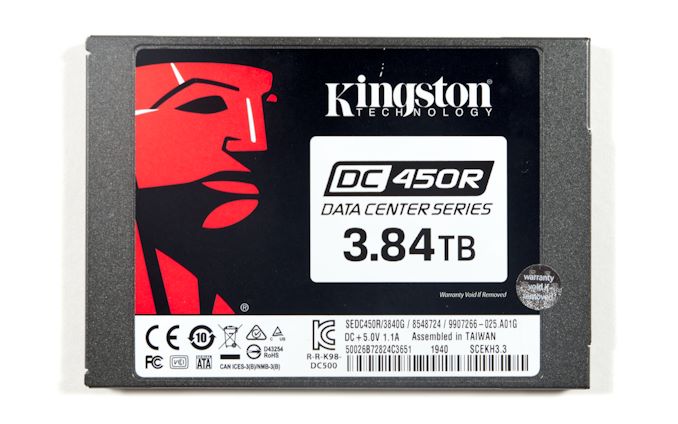Enterprise SATA SSDs: Can Budget 2020 beat Top Line 2017?
by Billy Tallis on February 4, 2020 11:00 AM EST
Every now and again we need to develop updated benchmarks to match the current workloads in the market. Today we're launching our updated 2020 Enterprise SSD test suite, and in order top draw comparisons of new to old, we're taking a look at two SATA SSDs that have almost nothing in common. From Kingston, we have their latest entry-level offering that stretches the definition of an enterprise SSD in pursuit of affordability. At the other end of the spectrum, we have the Micron 5100 MAX, a top of the line flagship model from two generations ago; old but not necessarily obsolete. We also have other drives in the mix, tested on the new suite, however these two are our main focus.
Kingston DC450R: The New Budget Enterprise SSD
The Kingston DC450R is part of a burgeoning market segment for entry-level server SSDs that compromise on one or more key features that traditionally define enterprise SSDs. Entry-level drives always tend to have endurance ratings and overprovisioning ratios comparable to consumer SSDs. That's certainly true of the DC450R, but it also eschews power loss protection capacitors. For many traditional server use cases, such as transactional databases, that would immediately disqualify the DC450R. But many of the most read-oriented workloads do not particularly need the extra data integrity assurances that power-loss capacitors provide - these use cases are fine with relying just on a accessing a filesystem (that likely has redundancy regardless). Content Delivery Network (CDN) servers are the best example of this: they only need to mirror content distributed from a central source, and there are no serious consequences if a single CDN node goes down—but they still can benefit from SSD performance.
| Kingston DC450R Series Specifications | ||||||
| Capacity | 480 GB | 960 GB | 1920 GB | 3840 GB | ||
| Form Factor | 2.5" 7mm SATA | |||||
| Controller | Phison PS3112-S12DC | |||||
| NAND Flash | Kioxia/Toshiba 512Gbit 96L 3D TLC | |||||
| DRAM | Micron DDR4-2666 | |||||
| Sequential Read | 560 MB/s | |||||
| Sequential Write | 510 MB/s | 530 MB/s | 530 MB/s | 525 MB/s | ||
| Random Read | 99k IOPS | 98k IOPS | 99k IOPS | 99k IOPS | ||
| Random Write | 17k IOPS | 26k IOPS | 28k IOPS | 26k IOPS | ||
| Power | Max Read | 1.25 W | 1.3 W | 1.42 W | 1.48 W | |
| Max Write | 4 W | 4.25 W | 4.5 W | 5.5 W | ||
| Idle | 1.05 W | 1.15 W | 1.22 W | 1.3 W | ||
| Warranty | 5 years | |||||
| Write Endurance | 285 TB 0.3 DWPD |
582 TB 0.3 DWPD |
1301 TB 0.4 DWPD |
2823 TB 0.4 DWPD |
||
The Kingston DC450R is a clear derivative of the DC500 series. We're looking at the same basic PCB layout, but now with empty pads where the DC500s have power loss protection capacitors. Our 3.84TB DC450R sample includes 4GB of DDR4-2666 DRAM and sixteen NAND packages each containing 256GB, spread across four dies of 512Gbit each. The NAND this time is Kioxia/Toshiba BiCS4 96L TLC. This is rated for 3k Program/Erase cycles compared to the 5k P/E rating of the 64L Intel TLC used in the DC500 series.
Micron 5100 Max: 2017 Enterprise Performer
The 1.92TB Micron 5100 MAX may seem to be an odd drive to be reviewing in 2020, given that it was announced at the end of 2016 and has been replaced by two newer generations. We're reviewing it because MyDigitalDiscount has a batch of several thousand unused drives from an OEM excess deal, and they're selling them off for $299.99 each. That's in the same ballpark as the DC450R above and other entry-level server SSDs. And the 5100 MAX was top of the line for its time, rated for 5 drive writes per day and loaded with all the bells and whistles (TCG Enterprise encryption, power loss protection capacitors). Because the SATA interface hasn't gotten any faster in the years since the 5100 MAX was released, it stands a good chance of holding its own against modern drives. The one big caveat is that this drive is not being sold with the original manufacturer's warranty, but MyDigitalDiscount is providing their own warranty with the same 5-year/17600 TBW terms.
| Micron 5100 Series Specifications Comparison | ||||
| 5100 ECO | 5100 PRO | 5100 MAX | ||
| Form Factor | 2.5" 7mm and single-sided M.2 2280 | 2.5" | ||
| Capacities |
480GB– 7680GB (2.5") |
240GB–3840GB (2.5") |
240GB–1920GB |
|
| Controller | Marvell 88SS1074 | |||
| Interface | SATA 6Gb/s | |||
| NAND | Micron 384Gb 32-layer 3D TLC | |||
| Sequential Read | 540 MB/s | |||
| Sequential Write | 380–520 MB/s | 250–520 MB/s | 310–520 MB/s | |
| Random Read | 93k IOPS | 78k–93k IOPS | 93k IOPS | |
| Random Write | 9k–31k IOPS | 26k–43k IOPS | 48k–74k IOPS | |
| Endurance | 0.45–8.4 PB | 0.65–17.6 PB | 2.2–17.6 PB | |
| Encryption | optional TCG Enterprise and FIPS 140-2 validation | |||
Inside the 5100 MAX we find the Marvell 88SS1074 controller, which was also used in Crucial consumer SATA drives until they switched to Silicon Motion with the MX500. The NAND flash is Micron 32L 3D TLC. This was Micron's first generation of 3D NAND and the die was designed as more of a MLC-first product even though it ended up being used predominantly as TLC. So what would have been 256Gbit dies as MLC are used as 384Gbit TLC parts, and four of them per package adds up to 192GB. Sixteen of these gives a nominal raw capacity of about 3072 GiB on a drive with 1920GB usable capacity, for an incredible 42% overprovisioning ratio compared to the 12% on the Kingston DC450R. The 5100 MAX uses 2GB of Micron DDR3-1600 DRAM. The power loss protection capacitors are lined up around the edges of the PCB.
One unusual feature of the 5100 MAX is that it will optionally use 12V power if provided. Most SATA SSDs use the 5V supply exclusively, and the 5100 MAX can run without the 12V supply. Our testing was conducted with the 12V supply turned on, but it wasn't until we saw power efficiency scores that looked too good to be true that we realized the calculations needed to include the 12V rail for this drive needed. Fortunately, our Quarch HD Programmable Power Module always records from both rails simultaneously, so we didn't need to re-run any tests.
Our Micron 5100 MAX arrived with the outdated D0MU037 firmware version, and we updated it to D0MU071 before testing.
This Review
For this review, we've overhauled our enterprise SSD test suite. The overall structure of our tests is the same, but a lot has changed under the hood. We're using newer versions of our benchmarking tools and the latest longterm support kernel branch. The tests have been reconfigured to drastically reduce CPU overhead, which has minimal impact on the SATA drives in this review but lets us properly push the limits of the many enterprise NVMe drives that have also been running through the new test suite this winter. We'll go into more detail about that in our upcoming enterprise NVMe review.
| Enterprise SSD Test System | |
| System Model | Intel Server R2208WFTZS |
| CPU | 2x Intel Xeon Gold 6154 (18C, 3.0GHz) |
| Motherboard | Intel S2600WFT Firmware 2.01.0009 CPU Microcode 0x2000065 |
| Chipset | Intel C624 |
| Memory | 192GB total, Micron DDR4-2666 16GB modules |
| Software | Linux kernel 5.4.0 fio version 3.16 |
| Thanks to StarTech for providing a RK2236BKF 22U rack cabinet. | |
The Kingston DC450R's closest competitor is probably the Samsung 860 DCT, another entry-level server SSD that also lacks power loss protection. We also have results for Samsung's next step up, the 883 DCT which is another TLC-based drive but with all the usual enterprise features. From Kingston we have the DC500R and DC500M, the next two steps up their enterprise SSD product lineup. There are few direct competitors to the Micron 5100 MAX from current-generation SSDs; the high-performance/high-endurance market segments have largely moved over to NVMe or are lingering on SAS. Even Samsung's SM883 MLC SATA drive is only rated for 3 DWPD to the Micron's 5 DWPD. But at the price MyDigitalDiscount is charging for their stock of the 5100 MAX, it's totally fair to compare it against the more recent low-end enterprise SATA models. For the sake of comparison, we've also included results from the Samsung 983 DCT NVMe SSD, but we've omitted it from some graphs where it distorts the scale too much.




















20 Comments
View All Comments
romrunning - Tuesday, February 4, 2020 - link
I understand the reason (batch of excess drives leftover from OEM) for using the Micro 5100 MAX, but for "enterprise" SSD use, I really would have liked to see Intel's DC-series (DC = Data Center) of enterprise SSDs compared.DanNeely - Tuesday, February 4, 2020 - link
This is a new benchmark suite, which means all the drives Billy has will need to be re-ran through it to get fresh numbers which is why the comparison selection is so limited. More drives will come in as they're retested; but looking at the bench SSD 2018 data it looks like the only enterprise SSDs Intel has sampled are Optanes.Billy Tallis - Tuesday, February 4, 2020 - link
This review was specifically to get the SATA drives out of the way. I also have 9 new enterprise NVMe drives to be included in one or two upcoming reviews, and that's where I'll include the fresh results for drives I've already reviewed like the Intel P4510, Optane P4800X and Memblaze PBlaze5.I started benchmarking drives with the new test suite at the end of November, and kept the testbed busy around the clock until the day before I left for CES.
romrunning - Wednesday, February 5, 2020 - link
I appreciate getting more enterprise storage reviews! Not enough of them, especially for those times when you might have some leeway on which storage to choose.pandemonium - Wednesday, February 5, 2020 - link
Agreed. I'm curious how my old pseudo enterprise Intel 750 would compare here.Scipio Africanus - Tuesday, February 4, 2020 - link
I love those old stock enterprise drives. Before I went NVME just a few months ago, my primary drive was a Samsung SM863 960gb which was a pumped up high endrance 850 Pro.shodanshok - Wednesday, February 5, 2020 - link
Hi Billy, thank for the review. I always appreciate similar article.That said, this review really fails to take into account the true difference between the listed enterprise disks, and this is due to a general misunderstanding on what powerloss protection does and why it is important.
In the introduction, you state that powerloss protection is a data integrity features. While nominally true, the real added value of powerloss protection is much higher performance for synchronized write workloads (ie: SQL databases, filesystem metadata update, virtual machines, etc). Even disks *without* powerloss protection can give perfect data integrity: this is achieved with flush/fsync (on application/OS side) and SATA write barrier/FUAs. Applications which do not use fsync will be unreliable even on drive featuring powerloss protection, as any write will be cached in the OS cache for a relatively long time (~1s on Windows, ~30s on Linux), unless opening the file in direct/unbuffered mode.
Problem is, synchronous writes are *really* expensive and slow, even for flash-backed drive. I have the OEM version of a fast M.2 Samsung 960 EVO NVMe drive and in 4k sync writes it show only ~300 IOPs. For unsynched, direct writes (ie: bypassing OS cache but using its internal DRAM buffer), it has 1000x the IOPs. To be fast, flash really needs write coalescing. Avoiding that (via SATA flushes) really wreack havok on the drive performance.
Obviously, not all writes need to be synchronous: most use cases can tolerate a very low data loss window. However, for application were data integrity and durability are paramount (as SQL databases), sync writes are absolutely necessary. In these cases, powerloss protected SSD will have performance one (or more) order of magnitude higher than consumer disks: having a non-volatile DRAM cache (thank to power capacitors), they will simply *ignore* SATA flushes. This enable write aggregation/coalescing and the relative very high performance advantage.
In short: if faced with a SQL or VM workload, the Kingston DC450R will fare very poorly, while the Micron 5100 MAX (or even the DC500R) will be much faster. This is fine: the DC450R is a read-intensive drive, not intended for SQL workloads. However, this review (which put it against powerloss protected drives) fails to account for that key difference.
mgiammarco - Thursday, February 6, 2020 - link
I agree perfectly finally someone that explains the real importance of power loss protection. Frankly speaking an "enterprise ssd" without plp and with low write endurance is really should be called "enterprise"? Which is the difference with a standard sdd?AntonErtl - Wednesday, February 5, 2020 - link
There is a difference between data integrity and persistency, but power-loss protection is needed for either.Data integrity is when your data is not corrupted if the system fails, e.g., from a poweroff; this needs the software (in particular the data base system and/or file system) to request the writes in the right order), but it also needs the hardware to not reorder the writes, at least as far as the persistent state is concerned. Drives without power-loss protection tend not to give guarantees in this area; some guarantee that they will not damage data written long ago (which other drives may do when they consilidate the still-living data in an erase block), but that's not enough for data integrity.
Persistency is when the data is at least as up-to-date as when your last request for persistency (e.g., fsync) was completed. That's often needed in server applications; e.g., when a customer books something, the data should be in persistent storage before the server sends out the booking data to the customer.
shodanshok - Wednesday, February 5, 2020 - link
fsync(), write barrier and SATA flushes/FUAs put strong guarantee on data integrity and durability even *without* powerloss protected drive cache. So, even a "serious" database running on any reliable disk (ie: one not lying about flushes) will be 100% functional/safe; however, performance will tank.A drive with powerloss protected cache will give much higher performance but, if the application is correctly using fsync() and the OS supports write barrier, no added integrity/durability capability.
Regarding write reordering: write barrier explicitly avoid that.